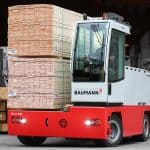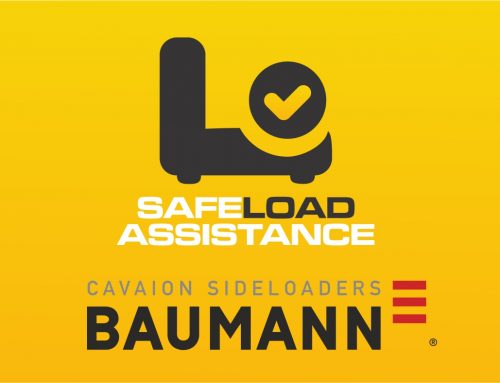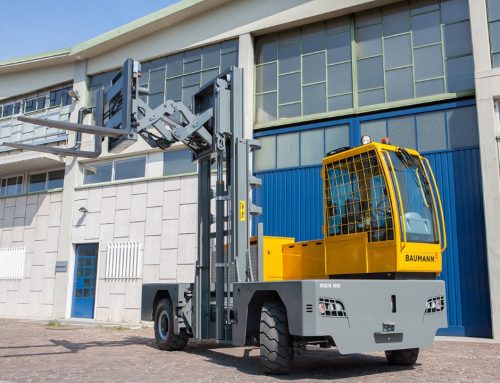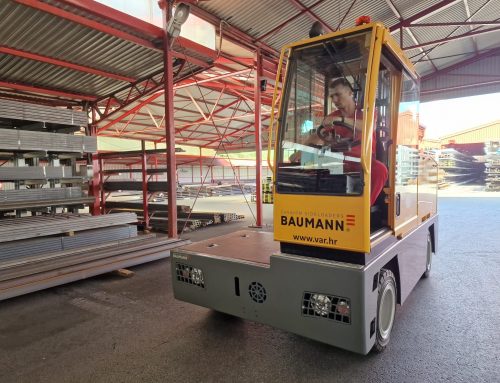Sideloaders are perfect and widely used in timber and forestry, but what is the best sideloader for the timber industry?
Forestry and timber businesses were the first to see the benefits of sideloader use. In many timber producing regions of Europe, ‘Baumann’ and ‘sideloader’ are inter-changeable.
The basic reasons are obvious – long loads are tricky to handle; sideloaders hold them securely. Long loads take up space; sideloaders are space efficient.
Why Are Sideloaders So Popular In The Timber Sector?
Traditional sawmills and timber processing businesses are often found in mountainous regions, either on sloped sites or in tight valleys. The raw material can be stored outside, but is bulky, meaning space is usually at a premium. Being able to reduce aisle widths and turn in tight spaces makes a lot of sense.
Even in the wide-open spaces of modern sawmills, such as BSW Group’s 15 ha (37 acres) Carlisle site, the uneven ground and distances travelled makes the sideloader an obvious choice.
Comfort and visibility are also improved by being forwards-facing and sat above the deck, and contrary to what some non-users may think, the operator spends less time looking over his shoulder when working than a traditional counterbalance forklift driver.
The best sideloaders for the timber industry are durable, built to exacting standards with masts that have a unique profile designed for the demands of working sideways. The trucks can cope with the ground conditions and have features that enable forks to lift loads that are not always perfectly horizontal – a single fork that can move independently. The feature has also proved popular for those handling roof trusses.
New sideloader technology
With such an established history, some manufacturers have done little to push the technology forward, but that cannot be said of Baumann. Baumann is renowned as an innovator in the important areas of safety and productivity.
The entire sideloader chassis pivots to provide the equivalent of tilt on a forklift mast, and Baumann sideloaders also adapt to the ground conditions to ensure the bed remains level, even with the ground is not.
Hydraulic cylinders traditionally drive a sideloader outreach system (the method by which the forks reach out to the load and return it to the load bed) by applying pressure to opposing rollers that slide along their respective channels, in a pantograph-style mechanical linkage.
 The design has inherent issues, caused by friction phenomena, which can cause sudden oscillation movements of the carriage and mast. Aside from adding sideways pressure and stress on the chassis, it means regular maintenance and an experienced, competent operator are essential.
The design has inherent issues, caused by friction phenomena, which can cause sudden oscillation movements of the carriage and mast. Aside from adding sideways pressure and stress on the chassis, it means regular maintenance and an experienced, competent operator are essential.
Frequent impacts can reduce the roller durability, whilst wear and tear also reduces the pre-stressed nature of the tapered sides, designed-in to maintain constant contact between roller and channel, again reducing the system’s lifespan.
One of the biggest innovations since the sideloader was first produced is the Variable Reach System (VRS), otherwise known as Baumann’s award-winning Archimedes outreach system.
This patented system utilises the direct drive Archimedes screw to extend the fork carriage, whilst preventing transverse movements and eliminating unnecessary stresses.
The worm gear system and rollers can work only in combination, which means ideal results each time, and the maximum working speeds – results never before reached.
The system is low in maintenance and simple in design, with a high level of engineering and durability to ensure greater safety, smoother joystick control and perfectly synchronised outreach for highly accurate and efficient load handling.
Electric Sideloaders For The Timber Industry
There was a time when every sideloader was powered by diesel, but today’s timber businesses are seen as important custodians of the environment and are looking to reduce their carbon tyreprints.
Some even use their by-products for their own on-site electricity generation. That’s led to a surge in demand for electric models, and the Baumann EGX80L is the largest capacity 120v electric sideloaders available on the market, with the best battery shift life.
In developing the EGX range the goal was to produce a highly efficient and durable machine capable of working in demanding applications.
Electrics offer zero emissions, are cheaper to run and maintain, as well as offering a better operator environment. The initial investment is now also on a par with IC models, whilst noise and vibration reduction provides almost as much satisfaction as the cost savings.
The EGX has two drive motors and larger capacity one-piece battery that can be lifted off the chassis and swapped for a freshly charged one. Large diameter hydraulic pipes were used on the EGX to reduce the energy needed to drive key functions such as lift and outreach.
This required a series of new solutions to overcome the routing of large pipes to the downstream pressure compensator and on to the mast.
The comfort, durability and high performance of the Baumann adds up to an impressive package. Even after half a century, the technology is still evolving, with yet further improvements already in progress.
Want to know more?
If you would like to have a chat with one of our sales people, get in touch. We operate across Europe and can advise you on the best sideloader for your timber yard or forestry site.






